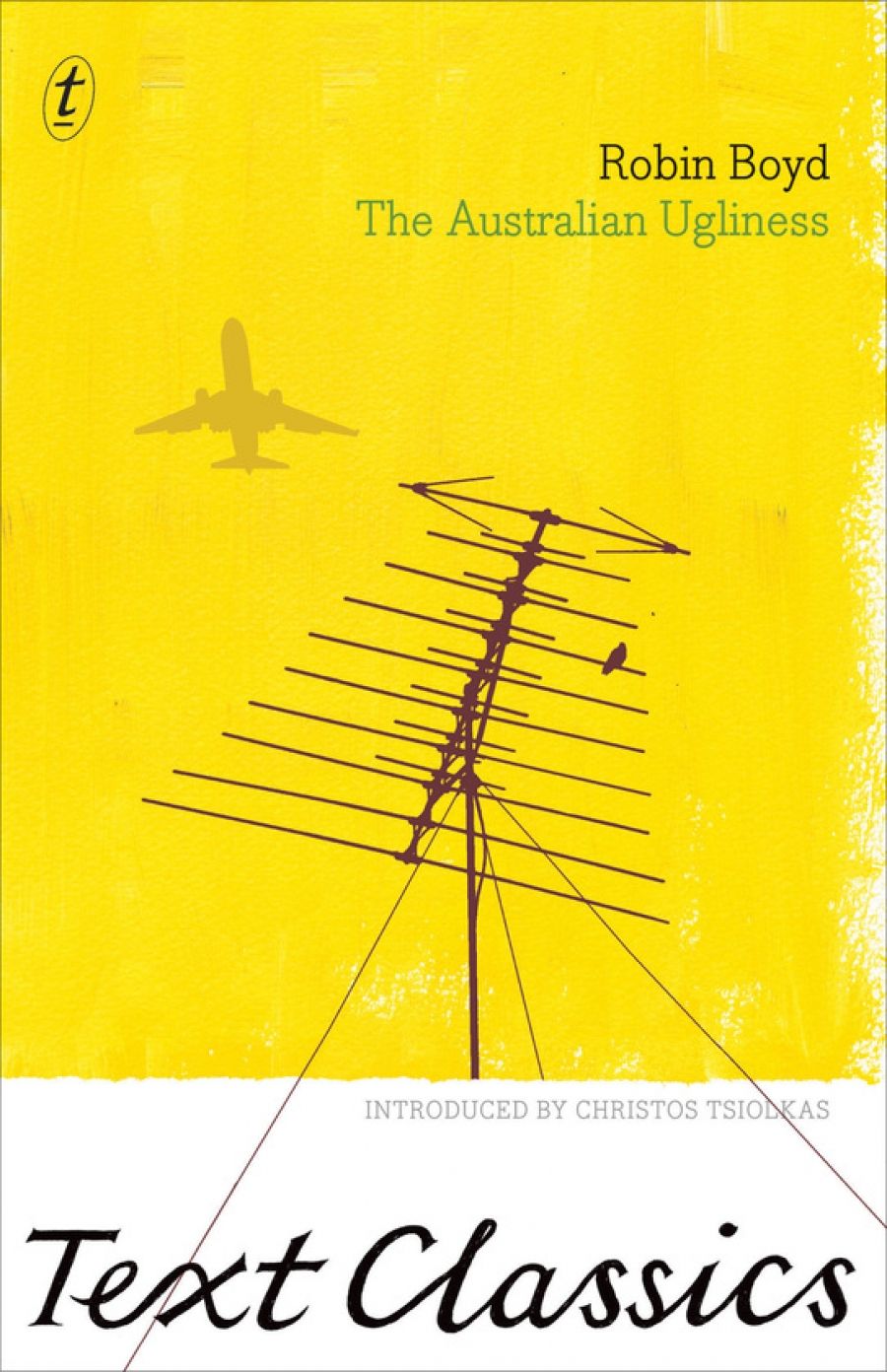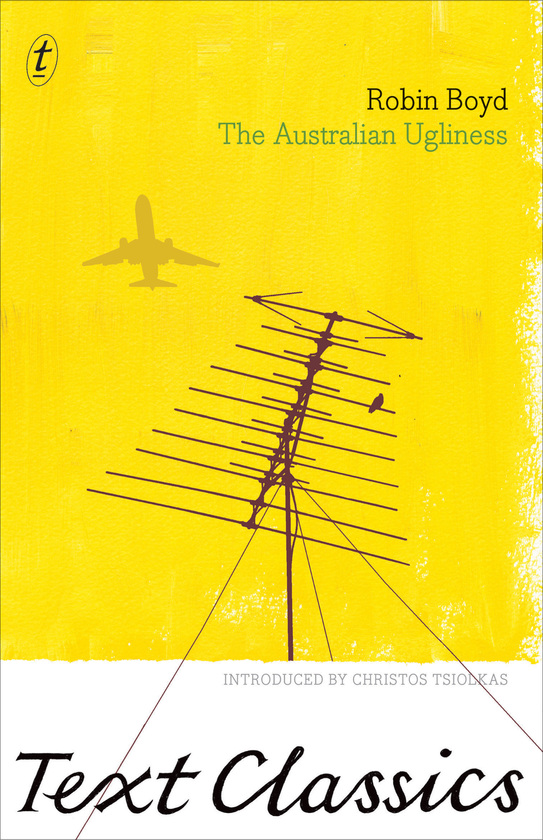
- Free Article: No
- Contents Category: Architecture
- Review Article: Yes
- Article Title: Back to Austerica
- Article Subtitle: Robin Boyd's classic book still painfully valid
- Online Only: No
- Custom Highlight Text:
How differently would we view Australia’s postwar architecture and urban design without Robin Boyd’s The Australian Ugliness? Such is the significance of this classic 1960 text that it has shaped debates about our cities – their planning, development and buildings – for half a century. Whether the book has helped to improve them is questionable – they probably would not be much different today, Boyd or no Boyd – but what a context and framework he gives us for analysing and discussing them. With the dramatic changes in society and tastes in fifty years, what does Boyd offer the contemporary reader?
- Book 1 Title: The Australian Ugliness
- Book 1 Biblio: Text, $34.95 pb, 300 pp
- Book 1 Cover Small (400 x 600):

What also will keep The Australian Ugliness relevant is Boyd’s crisp, elegant and witty prose style. In his précis of the sad story of Canberra’s design, he neatly summarises the city’s predicament:
The Canberra in which the mid-century Australian motorist lost himself, in which a pedestrian was confounded as in a Victorian maze, had all the practical disadvantages of Griffin’s idea without one of the artistic advantages which motivated him.
His comments on other cities – the beauty of Hobart’s setting and its colonial architecture, Adelaide’s remarkable city plan and taxi drivers who opened the door for passengers – deftly illustrate his journalistic skills and the ability to distil his cogent observations in a few words.
Rereading The Australian Ugliness after several years, one is struck again by the range and depth of Boyd’s interests and by the aptness and surety of his judgements. While his aim is to present and analyse contemporary architecture and design in Australia with a view to improving it – this is what has made the book so famous – he also has a fine understanding of the history of architecture in Australia going back to the early colonial period. This might seem strange for an architect whose own work is determinedly modernist. However, Boyd’s historical knowledge of architecture underpinned his own work, and his admiration for, and interest in, Georgian architecture in this country is not out of character, given its understated elegance and refined ornament. In the 1950s, several key works on Australian nineteenth-century architecture were published, and Boyd followed these with interest, referring to them in his text. He feels keenly the destruction of Sydney’s famed Burdekin House, and fears for Elizabeth Bay House (now magnificently restored). But he also admires some of the elaborate and richly ornamented architecture of the second half of the nineteenth century; William Wardell’s splendid 1883 Gothic-revival English, Scottish and Australian Bank (now ANZ) in Collins Street, Melbourne, is praised. Boyd appreciates much other Victorian architecture, knowing that it should not be judged on modernist terms. He even laments the postwar destruction of the many great piles built in boom-time Melbourne and the subdivided estates that have become victims of unimaginative planning and housing, crammed with soulless, barrack-like flats. Like other champions of modern design before him – William Morris springs to mind – Boyd was a great advocate for the preservation of the architectural past and recognised the important role the National Trust was playing in Australia during the 1950s.
Boyd was one of those rare creatures who wrote with the same facility with which he designed houses. He follows in the steps of the two giants of late nineteenth-century British design, Morris and Christopher Dresser, whose writings on art and design retain their lustre and relevance. But Boyd’s own style and interests are more in the tradition of Adolf Loos, the great Viennese modernist architect of the early twentieth century. Like Loos, Boyd wrote brilliantly, covering not just architecture, but all aspects of taste, with verve, wit, sarcasm and a good turn of phrase. Where Loos gave us ‘Ornament and Crime’ – the title of his 1908 essay – Boyd gave us ‘the Australian ugliness’, ‘the cream Australia policy’ (referring to the ubiquitous colour scheme of the late 1920s to the late 1940s), ‘Featurism’, ‘Austerica’, and (my favourite) ‘Arborophobe’. Like Loos, Boyd also admired good historical design solutions. Despite the reforming zeal of these architects, not everything they admired had to be modern.
Boyd is not always on the attack. His chapter ‘The Pursuit of Pleasingness’ leads the reader gently through some of the complexities of art and architectural theories through the ages, from the Ancient Greeks to the present day. This potted history of aesthetics provides a background to Boyd’s thinking and gives the interested reader many sources to pursue. He wryly notes that the pentagon, recommended by a sixteenth-century Italian writer as one of the ideal plan shapes for churches, was only adopted in the twentieth century with the building of the Pentagon in Washington. It is often interesting to see what a perceptive critic like Boyd thought of the work of his contemporaries. His comments on Frank Lloyd Wright’s impractical Guggenheim Museum in New York – he lets Lloyd Wright skewer himself: ‘If the pictures don’t fit, cut them in half’ – and the elegant Wilson Hall in Melbourne still make compelling reading.
In relating architecture and design closely to society and culture, Boyd follows the path of the nineteenth-century critic John Ruskin, who under-stood that art and architecture are a reflection of the society that produces them. One cannot reform one without reforming the other. (Is The Australian Ugliness, as Morris said of Ruskin’s ‘The Nature of Gothic’, ‘one of the very few necessary and inevitable utterances of the century’?) Boyd’s wide-ranging references extend far beyond the authors already mentioned. He even manages to work in Henry James’s The Spoils of Poynton (1897): not in the obvious way, by alluding to Mrs Gereth’s obsession with her house and her exquisite taste, but concerning the creative process and how James came to write the great novel.
The Australian Ugliness was popular from the start. First published in 1960, it was reprinted in February and April 1961, with a second edition in December that year and a reprint in 1963. It was republished again in 1963, reprinted in 1968 and remained in print until the 1980s. Geoffrey Serle, in his excellent Robin Boyd: A Life (1995), estimated the total sales were 50,000 copies. This 2010 edition by Text, which is to be lauded for making this seminal work available to a new generation, is presented in a more generous format than any previous one, making it pleasant to handle and read. While there is much to be said for publishing what is essentially a reprint of a classic text, retaining its original line drawings, there is still a need for a critical edition of Boyd’s book, certainly one with photographs. Younger readers, unless they are well versed in the history of Australian architecture before 1960, will simply not be able follow the visual argument. It is worth noting that two earlier editions were illustrated with photographs. (The 1968 revised edition contained two photographs to illustrate Boyd’s points, and the 1980 revised edition, with an afterword by Harry Seidler, included twenty-four photographs showing both the good and bad of late 1950s Australia.)
In his afterword, Seidler commented that when considering the relevance of Boyd’s book today, we ‘must bear in mind that the original text goes back to 1960. Yet it is very evident that even though significant cultural changes have taken place in Australia since then, most of the book’s critical content is still painfully valid.’ Thirty years later, the situation is little changed.
The Australian Ugliness should be compulsory reading for all urban planners, architects, and architectural and design commentators. Boyd is not prescriptive, he is too subtle for that, but those who make decisions on our architecture and planning, and those who write about such topics, can learn much from him.


Comments powered by CComment